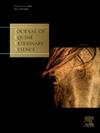Unveiling fertility decline in stallions: causes and outcomes
IF 1.3
3区 农林科学
Q2 VETERINARY SCIENCES
引用次数: 0
Abstract
Management of breeding stallions is crucial in equine reproduction. The long-life use of a stallion for a breeding career is the ultimate objective, whether it happens through natural mating or through semen collection and artificial insemination. This retrospective study investigated some aspects of the multifaceted decline in fertility among stallions, focusing on both the etiological factors and the repercussions for equine reproduction to aid breeding management. The first aim was to investigate the most common causes of infertility in stallions and their risk factors. A second objective was to evaluate the stallion's fertility after treatment. According to the history and the reason all stallions were classified into several groups, age-related decline (n=1), testicular and epididymal issues (n=5), infections (n=4), endocrine dysfunction (n=1), semen quality issues (n=3), poor management and nutrition (n=16), environmental and seasonal factors (n=7), trauma or injury (n=3), psychological factors (n=3). Data were collected and statistically analyzed from breeding records and veterinary evaluations about the different breed stallions with range age between 9 and 25 years referred to our clinic during 2016-2023(n=43). Revealing significant correlations between declining fertility rates and conditions and suboptimal management practices. Additionally, the impact of nutritional deficits and seasonal variations on reproductive performance was assessed. Our findings underscore the critical need for enhanced breeding management protocols and health monitoring to address fertility decline effectively. There were a number of conditions associated with poor fertility such as reproductive mismanagement 48%, anabolic steroid treatment, infectious and non-infectious pathology of reproductive organs 25%, behavioral 20% and endocrine disorders 7%(p<0.05). Optimal breeding management could be obtained by deeper understanding of stallion reproductive health, informing strategies to improve breeding outcomes in the equine industry.
求助全文
约1分钟内获得全文
求助全文
来源期刊

Journal of Equine Veterinary Science
农林科学-兽医学
CiteScore
2.70
自引率
7.70%
发文量
249
审稿时长
77 days
期刊介绍:
Journal of Equine Veterinary Science (JEVS) is an international publication designed for the practicing equine veterinarian, equine researcher, and other equine health care specialist. Published monthly, each issue of JEVS includes original research, reviews, case reports, short communications, and clinical techniques from leaders in the equine veterinary field, covering such topics as laminitis, reproduction, infectious disease, parasitology, behavior, podology, internal medicine, surgery and nutrition.
 求助内容:
求助内容: 应助结果提醒方式:
应助结果提醒方式:


